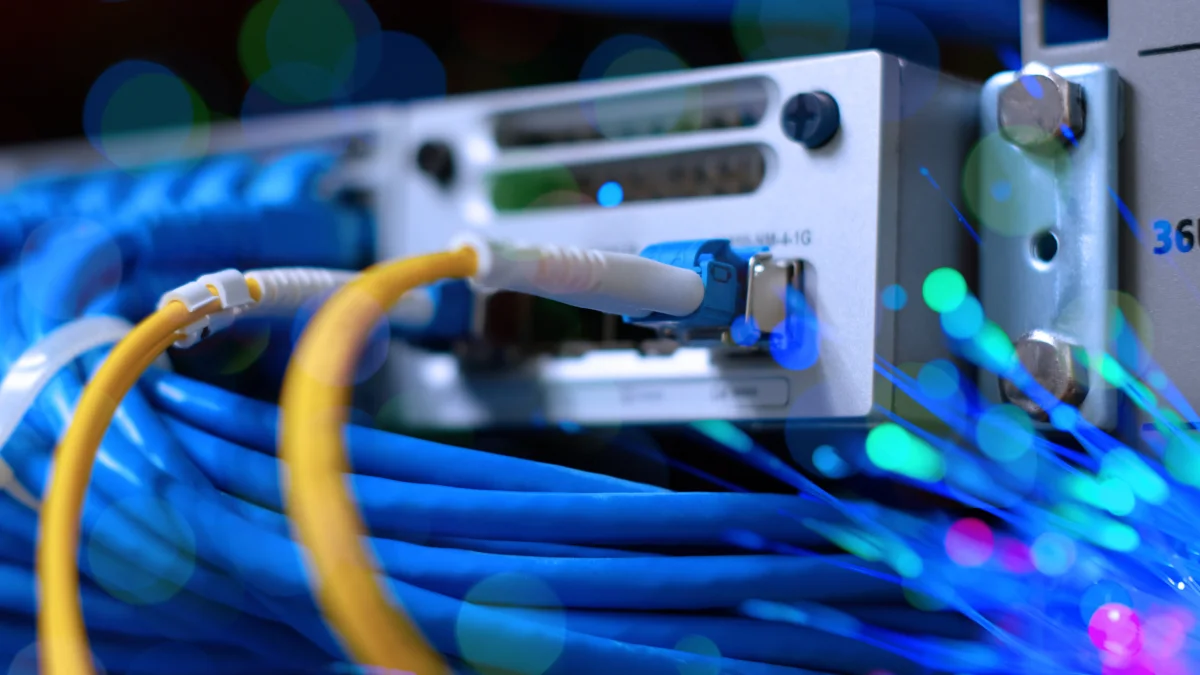1.
What is DSL?
DSL, short for "Digital Subscriber Line," is defined as a technology developed to provide internet connectivity. Translating to "Digital Subscriber Line," this technology comes in various forms such as ADSL, VDSL, SDSL, and G.SHDSL. Continue reading to learn what DSL is, its types, use cases, and the detailed relationship between this technology and cloud services.
DSL (Digital Subscriber Line) is a technology that delivers high-speed internet access over telephone lines. Data transmission in this system is carried out digitally over existing copper cables. Compared to traditional dial-up connections, DSL offers a much faster internet experience, providing speed and performance benefits depending on user needs and distance through its different types.
How Does DSL Work?
DSL works by using a frequency band different from the one used for voice calls on the telephone line. This allows both telephone calls and internet connectivity over the same line simultaneously. DSL modems convert digital data into signals suitable for telephone lines and connect to the Internet Service Provider (ISP) via DSLAM (Digital Subscriber Line Access Multiplexer) devices. At this stage, data transmission can be either symmetric (SDSL) or asymmetric (ADSL, VDSL). In symmetric connections, download and upload speeds are equal, whereas in asymmetric connections, download speed is higher than upload speed. Additionally, as the distance between the user and the central office increases, the connection speed may decrease. For this reason, different DSL types have been developed to provide higher speeds over shorter distances. DSL technology offers a cost-effective and stable internet solution for home users and small businesses while meeting daily internet needs such as video streaming, cloud applications, email, and web browsing.

2.
Types of DSL
- ADSL (Asymmetric Digital Subscriber Line): ADSL, one of the most common choices for home users, is an asymmetric connection where download speed is higher than upload speed.
- VDSL (Very-high-bit-rate Digital Subscriber Line): VDSL delivers higher speeds than ADSL and is particularly suitable for video streaming, cloud-based applications, and online gaming.
- SDSL (Symmetric Digital Subscriber Line): SDSL, offering equal upload and download speeds, is an ideal connection type for small and medium-sized businesses.
- G.SHDSL (Symmetric High-speed Digital Subscriber Line): Similar to SDSL, G.SHDSL provides symmetric speeds and is commonly used for enterprise applications and remote office connections.
What is VDSL?
The questions What is ADSL and What is VDSL are frequently asked in the context of DSL technology, and their detailed answers are provided in this section. VDSL, short for Very-high-bit-rate Digital Subscriber Line, as briefly explained above, is an advanced version of DSL technology delivering high-speed internet access over short distances. Compared to ADSL, VDSL offers significant improvements in both download and upload speeds and is particularly suitable for video streaming, online gaming, and cloud-based applications. The main advantage of VDSL is that it can deliver much higher speeds over existing copper telephone lines compared to other DSL technologies; however, fiber infrastructure technologies always offer greater speed and capacity than VDSL.
What is ADSL?
As we elaborate on what DSL means, let us now define ADSL. ADSL (Asymmetric Digital Subscriber Line) is the most widely used type of DSL technology, providing asymmetric data transmission—meaning the download speed is higher than the upload speed. Suitable for home users and small businesses, ADSL offers a cost-efficient solution while providing adequate performance for everyday internet needs such as web browsing, email, social media, and video streaming. Additionally, it operates over existing telephone lines, eliminating the need for extra cabling.
3.
Difference Between ADSL, VDSL, and SDSL
The differences between ADSL, VDSL, and SDSL are generally evaluated in terms of speed, performance, and cost. ADSL offers a lower-cost solution usable over longer distances. It provides higher download than upload speeds, delivering sufficient performance for home users. In contrast, VDSL provides much higher speed and performance than ADSL over shorter distances, making it ideal for high-resolution video, online gaming, and cloud applications. Consequently, VDSL is typically more expensive than ADSL. SDSL offers symmetric speeds, meaning upload and download speeds are equal. It is suitable for businesses and users handling intensive data transfers but is more expensive compared to ADSL and VDSL. The table below compares these DSL types in terms of speed, performance, and cost.
| DSL Type |
Speed |
Performance |
Cost |
| ADSL |
Low–Medium (download speed higher than upload speed) |
Adequate for home users, general internet usage |
Typically the most cost-effective option |
| VDSL |
Medium–High (higher download and upload speeds) |
Ideal for video streaming, online gaming, and cloud applications |
Mid-range pricing |
| SDSL |
Medium (symmetric upload and download speeds) |
Suitable for businesses and professional users with heavy data transfers |
Typically higher cost (for enterprise use) |
4.
DSL Technology and Cloud Services
As DSL technology forms the basic infrastructure for internet connectivity, it plays a critical role in accessing cloud services. Types of DSL such as ADSL, VDSL, or SDSL enable users to connect quickly and securely to cloud-based storage, data backup, office applications, and SaaS (Software as a Service) platforms. Particularly, the high and symmetric speeds offered by VDSL and SDSL make them ideal for cloud applications requiring large file transfers, video conferencing, and continuous data synchronization. This way, DSL infrastructure enables cloud services to deliver efficient, seamless, and user-friendly experiences.
Additionally, you may also be interested in our article What is VPN? How to Set It Up?.
5.
Frequently Asked Questions
The DSL internet light is off. What could be the reason?
There may be several reasons why the DSL light is off. First, check the power connections of the modem or router. A line fault, disconnection, or an outage from the service provider could also cause the light to be off. Additionally, if there are issues with the telephone line filter or cable connections, the DSL light may not turn on.
The DSL light is blinking. What should I do?
A blinking DSL light usually indicates that the connection is being established. In this case, check the modem and telephone line connections to ensure the cables are properly connected. If the light keeps blinking for a long time, you may need to contact your service provider.
How to connect a DSL cable?
The DSL cable should be properly connected to both the telephone line and the modem. The cable from the telephone line should be connected to the filter if one is used; otherwise, it should be connected directly to the modem. The modem’s DSL port is usually labeled separately, and the cable should be plugged in here.
Why doesn’t the DSL light turn on?
The main reasons why the DSL light does not turn on include inactive service lines, modem malfunctions, incorrect cable connections, or outages on the service provider’s side. First, ensure that the modem and cable connections are correct, and then contact your service provider.
How to connect an ADSL cable?
The ADSL cable is connected to the telephone line and then to the modem. The cable from the telephone line is connected to the ADSL filter (if used) and then to the ADSL port on the modem. This setup separates the internet signal, which is then transmitted through the modem to the computer or Wi-Fi network.
What is the difference between ADSL and VDSL?
The main difference between ADSL and VDSL lies in speed and performance. ADSL provides a slower internet connection where download speed is higher than upload speed, whereas VDSL offers higher performance for both download and upload speeds. Additionally, VDSL delivers better connection quality over shorter distances compared to ADSL, making it more suitable for video streaming, online gaming, and cloud applications.






























